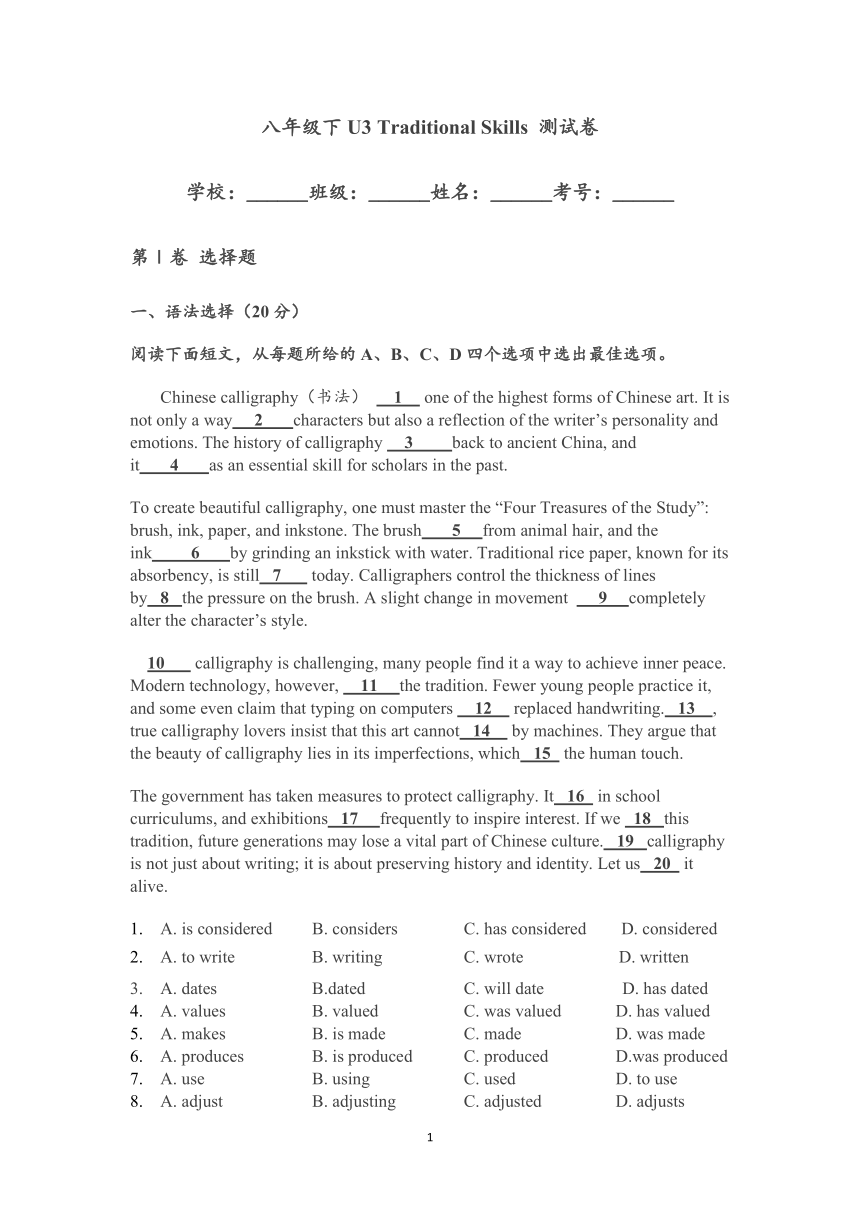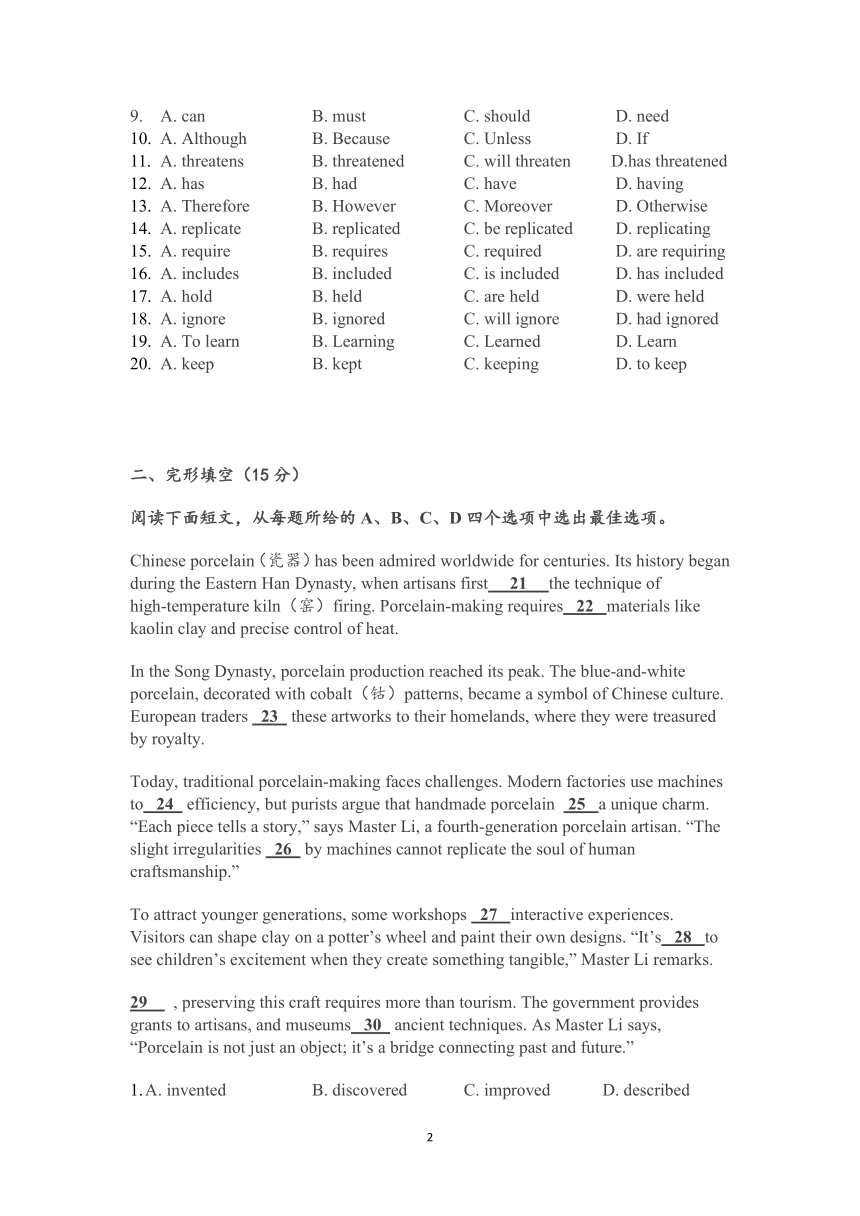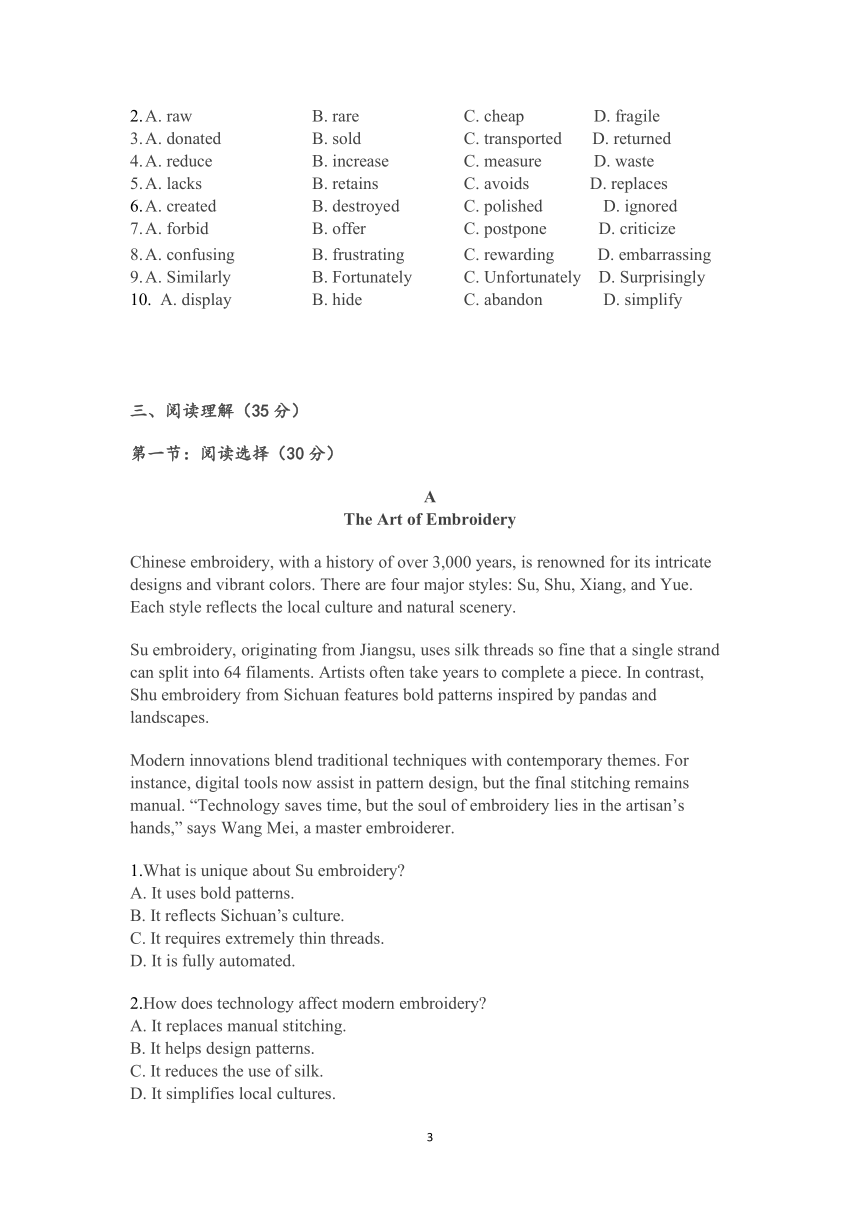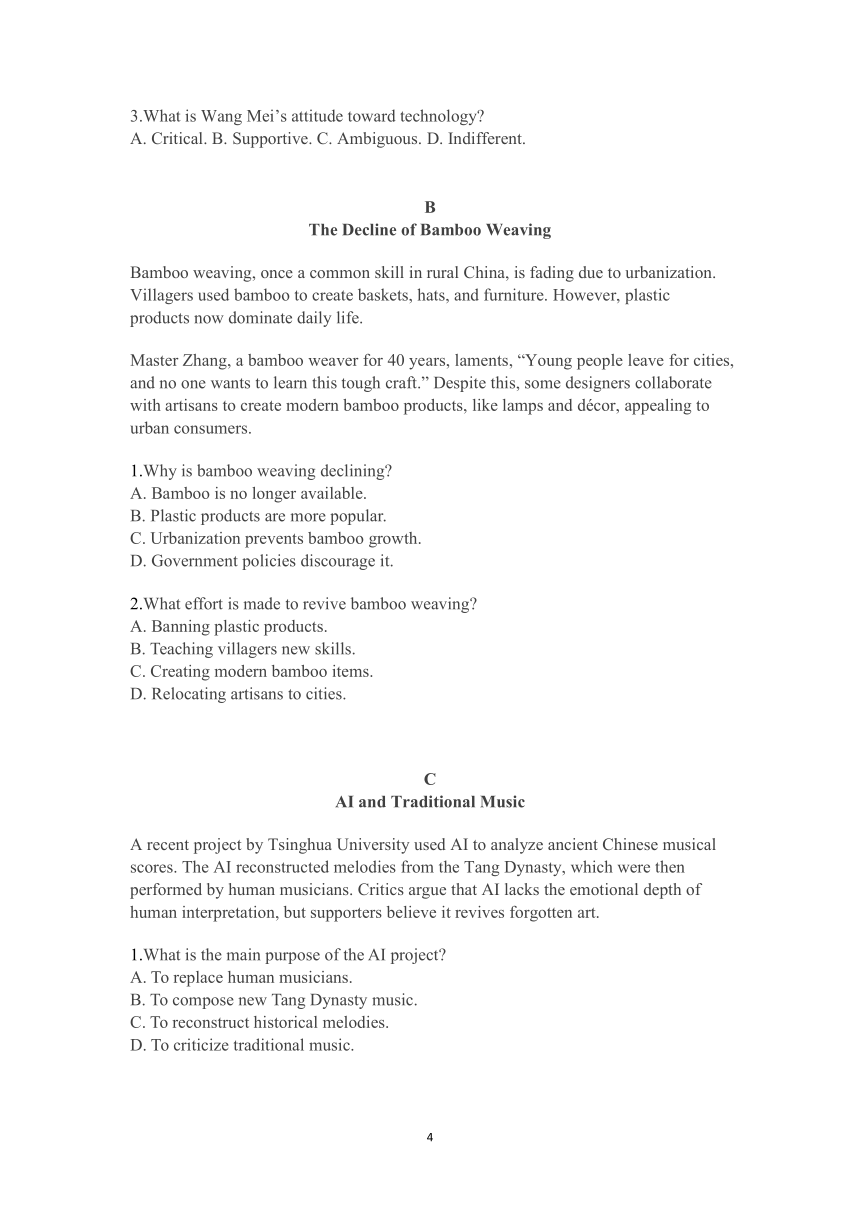八年级下册Module 2 Arts and crafts Unit 3 Traditional skills 试卷(含答案)
文档属性
| 名称 | 八年级下册Module 2 Arts and crafts Unit 3 Traditional skills 试卷(含答案) |  | |
| 格式 | |||
| 文件大小 | 256.3KB | ||
| 资源类型 | 试卷 | ||
| 版本资源 | 牛津深圳版 | ||
| 科目 | 英语 | ||
| 更新时间 | 2025-02-28 16:17:07 | ||
图片预览





文档简介
八年级下 U3 Traditional Skills 测试卷
学校:______班级:______姓名:______考号:______
第Ⅰ卷 选择题
一、语法选择(20分)
阅读下面短文,从每题所给的 A、B、C、D四个选项中选出最佳选项。
Chinese calligraphy(书法) 1 one of the highest forms of Chinese art. It is
not only a way 2 characters but also a reflection of the writer’s personality and
emotions. The history of calligraphy 3 back to ancient China, and
it 4 as an essential skill for scholars in the past.
To create beautiful calligraphy, one must master the “Four Treasures of the Study”:
brush, ink, paper, and inkstone. The brush 5 from animal hair, and the
ink 6 by grinding an inkstick with water. Traditional rice paper, known for its
absorbency, is still 7 today. Calligraphers control the thickness of lines
by 8 the pressure on the brush. A slight change in movement 9 completely
alter the character’s style.
10 calligraphy is challenging, many people find it a way to achieve inner peace.
Modern technology, however, 11 the tradition. Fewer young people practice it,
and some even claim that typing on computers 12 replaced handwriting. 13 ,
true calligraphy lovers insist that this art cannot 14 by machines. They argue that
the beauty of calligraphy lies in its imperfections, which 15 the human touch.
The government has taken measures to protect calligraphy. It 16 in school
curriculums, and exhibitions 17 frequently to inspire interest. If we 18 this
tradition, future generations may lose a vital part of Chinese culture. 19 calligraphy
is not just about writing; it is about preserving history and identity. Let us 20 it
alive.
1. A. is considered B. considers C. has considered D. considered
2. A. to write B. writing C. wrote D. written
3. A. dates B.dated C. will date D. has dated
4. A. values B. valued C. was valued D. has valued
5. A. makes B. is made C. made D. was made
6. A. produces B. is produced C. produced D.was produced
7. A. use B. using C. used D. to use
8. A. adjust B. adjusting C. adjusted D. adjusts
1
9. A. can B. must C. should D. need
10. A. Although B. Because C. Unless D. If
11. A. threatens B. threatened C. will threaten D.has threatened
12. A. has B. had C. have D. having
13. A. Therefore B. However C. Moreover D. Otherwise
14. A. replicate B. replicated C. be replicated D. replicating
15. A. require B. requires C. required D. are requiring
16. A. includes B. included C. is included D. has included
17. A. hold B. held C. are held D. were held
18. A. ignore B. ignored C. will ignore D. had ignored
19. A. To learn B. Learning C. Learned D. Learn
20. A. keep B. kept C. keeping D. to keep
二、完形填空(15 分)
阅读下面短文,从每题所给的 A、B、C、D四个选项中选出最佳选项。
Chinese porcelain(瓷器)has been admired worldwide for centuries. Its history began
during the Eastern Han Dynasty, when artisans first 21 the technique of
high-temperature kiln(窑)firing. Porcelain-making requires 22 materials like
kaolin clay and precise control of heat.
In the Song Dynasty, porcelain production reached its peak. The blue-and-white
porcelain, decorated with cobalt(钴)patterns, became a symbol of Chinese culture.
European traders 23 these artworks to their homelands, where they were treasured
by royalty.
Today, traditional porcelain-making faces challenges. Modern factories use machines
to 24 efficiency, but purists argue that handmade porcelain 25 a unique charm.
“Each piece tells a story,” says Master Li, a fourth-generation porcelain artisan. “The
slight irregularities 26 by machines cannot replicate the soul of human
craftsmanship.”
To attract younger generations, some workshops 27 interactive experiences.
Visitors can shape clay on a potter’s wheel and paint their own designs. “It’s 28 to
see children’s excitement when they create something tangible,” Master Li remarks.
29 , preserving this craft requires more than tourism. The government provides
grants to artisans, and museums 30 ancient techniques. As Master Li says,
“Porcelain is not just an object; it’s a bridge connecting past and future.”
1.A. invented B. discovered C. improved D. described
2
2.A. raw B. rare C. cheap D. fragile
3.A. donated B. sold C. transported D. returned
4.A. reduce B. increase C. measure D. waste
5.A. lacks B. retains C. avoids D. replaces
6.A. created B. destroyed C. polished D. ignored
7.A. forbid B. offer C. postpone D. criticize
8.A. confusing B. frustrating C. rewarding D. embarrassing
9.A. Similarly B. Fortunately C. Unfortunately D. Surprisingly
10. A. display B. hide C. abandon D. simplify
三、阅读理解(35 分)
第一节:阅读选择(30 分)
A
The Art of Embroidery
Chinese embroidery, with a history of over 3,000 years, is renowned for its intricate
designs and vibrant colors. There are four major styles: Su, Shu, Xiang, and Yue.
Each style reflects the local culture and natural scenery.
Su embroidery, originating from Jiangsu, uses silk threads so fine that a single strand
can split into 64 filaments. Artists often take years to complete a piece. In contrast,
Shu embroidery from Sichuan features bold patterns inspired by pandas and
landscapes.
Modern innovations blend traditional techniques with contemporary themes. For
instance, digital tools now assist in pattern design, but the final stitching remains
manual. “Technology saves time, but the soul of embroidery lies in the artisan’s
hands,” says Wang Mei, a master embroiderer.
1.What is unique about Su embroidery
A. It uses bold patterns.
B. It reflects Sichuan’s culture.
C. It requires extremely thin threads.
D. It is fully automated.
2.How does technology affect modern embroidery
A. It replaces manual stitching.
B. It helps design patterns.
C. It reduces the use of silk.
D. It simplifies local cultures.
3
3.What is Wang Mei’s attitude toward technology
A. Critical. B. Supportive. C. Ambiguous. D. Indifferent.
B
The Decline of Bamboo Weaving
Bamboo weaving, once a common skill in rural China, is fading due to urbanization.
Villagers used bamboo to create baskets, hats, and furniture. However, plastic
products now dominate daily life.
Master Zhang, a bamboo weaver for 40 years, laments, “Young people leave for cities,
and no one wants to learn this tough craft.” Despite this, some designers collaborate
with artisans to create modern bamboo products, like lamps and décor, appealing to
urban consumers.
1.Why is bamboo weaving declining
A. Bamboo is no longer available.
B. Plastic products are more popular.
C. Urbanization prevents bamboo growth.
D. Government policies discourage it.
2.What effort is made to revive bamboo weaving
A. Banning plastic products.
B. Teaching villagers new skills.
C. Creating modern bamboo items.
D. Relocating artisans to cities.
C
AI and Traditional Music
A recent project by Tsinghua University used AI to analyze ancient Chinese musical
scores. The AI reconstructed melodies from the Tang Dynasty, which were then
performed by human musicians. Critics argue that AI lacks the emotional depth of
human interpretation, but supporters believe it revives forgotten art.
1.What is the main purpose of the AI project
A. To replace human musicians.
B. To compose new Tang Dynasty music.
C. To reconstruct historical melodies.
D. To criticize traditional music.
4
2.What is a criticism of AI in music
A. It is too expensive.
B. It cannot convey emotions.
C. It simplifies melodies.
D. It ignores historical accuracy.
D
The Revival of Lacquerware
Lacquerware, a craft dating back 7,000 years, involves coating objects with tree sap.
The process is time-consuming, requiring up to 100 layers. Recently, luxury brands
have incorporated lacquerware into high-end products, boosting its global prestige.
1.What makes lacquerware challenging to produce
A. The need for rare materials.
B. The complex layering process.
C. The lack of skilled artisans.
D. The high cost of tree sap.
2.How has lacquerware gained international attention
A. Through government promotions.
B. By collaborating with luxury brands.
C. By reducing production time.
D. Through online sales.
E
The Philosophy of Ink Making
Traditional Chinese ink sticks are made from pine soot and glue. The mixture is
pressed into molds and dried for years. Calligraphers believe aging improves the ink’s
quality. “Ink-making is like life—it requires patience and time,” says artisan Liu
Feng.
1.According to Liu Feng, what is key to ink-making
A. Speed. B. Precision. C. Patience. D. Innovation.
第二节:阅读填空(5 分)
根据短文内容,从短文后的选项中选出能填入空白处的最佳选项。
5
Chinese tea culture is deeply rooted in history. 1 It was initially used as medicine
before becoming a daily drink. The Tang Dynasty saw the creation of “The Classic of
Tea” by Lu Yu, which systematized tea preparation.
2 For example, the Gongfu tea ceremony emphasizes precise brewing
techniques, while the Japanese tea ceremony evolved from Chinese traditions.
Modern tea culture blends tradition with innovation. 3 Additionally, bubble tea,
invented in Taiwan, has become a global phenomenon.
4 Tea plantations attract tourists, and tea-tasting events promote cultural
exchange. As the world embraces healthier lifestyles, Chinese tea’s popularity
continues to grow.
5 As Lu Yu wrote, “Tea tempers the spirit and calms the mind.”
A. Tea also plays a role in tourism.
B. Tea has various brewing methods.
C. The history of tea spans over 4,000 years.
D. However, the core value of tea remains unchanged.
E. Matcha lattes and tea-infused desserts are now trendy.
第Ⅱ卷 非选择题(共 30 分)
一、短文填词(5 分)
根据首字母提示完成短文。
Chinese traditional crafts, such as cloisonné(景泰蓝)and kite-making, are treasures
of our culture. Cloisonné involves f___1___ metal wires with enamel(珐琅). It
requires great p___2___ and skill. Kites, invented over 2,000 years ago, were initially
used for military s___3___. Today, they are symbols of joy and creativity. However,
these crafts face challenges. Many artisans are e___4___ old, and young people
seldom show interest. We must take a___5___ to preserve them.
二、完成句子(10 分)
1.这种技艺需要多年的练习才能掌握。
This skill ______ years of practice ______ ______.
2.政府正在努力保护非物质文化遗产。
The government ______ ______ ______ protect intangible cultural heritage.
6
3.他不仅擅长书法,还会篆刻。
He ______ ______ ______ calligraphy but also seal carving.
4.如果没有人传承,这门手艺可能会消失。
If no one ______ ______ the craft, it might disappear.
5.传统文化在现代社会中仍然具有重要意义。
Traditional culture ______ ______ ______ in modern society.
三、书面表达(15 分)
假设你是李华,学校将举办“传统文化周”活动。请你写一篇英文演讲稿,介绍
一项中国传统技艺(如剪纸、泥塑、皮影戏等),内容包括:
1.技艺的历史与特点;
2.现状与保护措施;
3.你的感受与倡议。
要求:
80 词左右;
使用所给提示词:history, unique, endangered, workshops, pride
答案及解析
一、语法选择
7
1.A(is considered) 被动语态,主语为第三人称单数。
2.A(to write) 不定式作后置定语,修饰“way”。
3.A(dates) 固定搭配“date back to”。
4.C(was valued) 过去时被动语态。
5.B(is made) 被动语态描述制作过程。
6.B(is produced) 同上。
7.C(used) 过去分词作后置定语。
8.B(adjusting) 介词 by后接动名词。
9.A(can) 表示可能性。
10.A(Although) 让步状语从句。
11.A(threatens) 第三人称单数。
12.C(have) 现在完成时,主语为复数。
13.B(However) 前后句意转折。
14.C(be replicated) 情态动词被动语态。
15.A(require) 主语“imperfections”为复数。
16.C(is included) 被动语态。
17.C(are held) 被动语态,一般现在时。
18.A(ignore) 条件句中的一般现在时。
19.B(Learning) 动名词作主语。
20.A(keep) let sb. do结构。
二、完形填空
1.C(improved) 根据上下文,改进技术更合理。
2.A(raw) 原材料。
3.C(transported) 运输瓷器。
4.B(increase) 提高效率。
5.B(retains) 保留独特魅力。
6.A(created) 机器制造的瑕疵。
7.B(offer) 提供体验。
8.C(rewarding) 有意义的体验。
9.C(Unfortunately) 语义转折。
10.A(display) 展示技艺。
三、阅读理解
1.C(It requires extremely thin threads.) 原文提到“split into 64 filaments”。
8
2.B(It helps design patterns.) 原文提到“digital tools assist in pattern design”。
3.A(Critical.) 引语强调手工的重要性。
4.B(Plastic products are more popular.) 原文直接提及。
5.C(Creating modern bamboo items.) 设计师合作开发新产品。
6.C(To reconstruct historical melodies.) AI 分析古乐谱。
7.B(It cannot convey emotions.) 批评者观点。
8.B(The complex layering process.) 需涂抹上百层。
9.B(By collaborating with luxury brands.) 与奢侈品牌合作。
10.C(Patience.) 引语强调耐心。
阅读填空
1.C 2. B 3. E 4. A 5. D
非选择题答案
一、短文填词
1.fixing 2. patience 3. signals 4. elderly 5. actions
二、完成句子
1.requires, to master
2.is making efforts to
3.is good at not only
4.passes down
5.still plays an important role
三、书面表达(参考范文)
Ladies and gentlemen,
Today, I’d like to introduce shadow puppetry, a traditional art with a history of over
2,000 years. It uses leather figures to tell stories through shadows. Each puppet is
hand-carved and painted, showing unique patterns.
Sadly, this art is endangered due to a lack of inheritors. To protect it, workshops are
teaching young people the skills.
9
As a Chinese student, I take pride in our culture. Let’s join hands to keep traditions
alive!
Thank you!
10
学校:______班级:______姓名:______考号:______
第Ⅰ卷 选择题
一、语法选择(20分)
阅读下面短文,从每题所给的 A、B、C、D四个选项中选出最佳选项。
Chinese calligraphy(书法) 1 one of the highest forms of Chinese art. It is
not only a way 2 characters but also a reflection of the writer’s personality and
emotions. The history of calligraphy 3 back to ancient China, and
it 4 as an essential skill for scholars in the past.
To create beautiful calligraphy, one must master the “Four Treasures of the Study”:
brush, ink, paper, and inkstone. The brush 5 from animal hair, and the
ink 6 by grinding an inkstick with water. Traditional rice paper, known for its
absorbency, is still 7 today. Calligraphers control the thickness of lines
by 8 the pressure on the brush. A slight change in movement 9 completely
alter the character’s style.
10 calligraphy is challenging, many people find it a way to achieve inner peace.
Modern technology, however, 11 the tradition. Fewer young people practice it,
and some even claim that typing on computers 12 replaced handwriting. 13 ,
true calligraphy lovers insist that this art cannot 14 by machines. They argue that
the beauty of calligraphy lies in its imperfections, which 15 the human touch.
The government has taken measures to protect calligraphy. It 16 in school
curriculums, and exhibitions 17 frequently to inspire interest. If we 18 this
tradition, future generations may lose a vital part of Chinese culture. 19 calligraphy
is not just about writing; it is about preserving history and identity. Let us 20 it
alive.
1. A. is considered B. considers C. has considered D. considered
2. A. to write B. writing C. wrote D. written
3. A. dates B.dated C. will date D. has dated
4. A. values B. valued C. was valued D. has valued
5. A. makes B. is made C. made D. was made
6. A. produces B. is produced C. produced D.was produced
7. A. use B. using C. used D. to use
8. A. adjust B. adjusting C. adjusted D. adjusts
1
9. A. can B. must C. should D. need
10. A. Although B. Because C. Unless D. If
11. A. threatens B. threatened C. will threaten D.has threatened
12. A. has B. had C. have D. having
13. A. Therefore B. However C. Moreover D. Otherwise
14. A. replicate B. replicated C. be replicated D. replicating
15. A. require B. requires C. required D. are requiring
16. A. includes B. included C. is included D. has included
17. A. hold B. held C. are held D. were held
18. A. ignore B. ignored C. will ignore D. had ignored
19. A. To learn B. Learning C. Learned D. Learn
20. A. keep B. kept C. keeping D. to keep
二、完形填空(15 分)
阅读下面短文,从每题所给的 A、B、C、D四个选项中选出最佳选项。
Chinese porcelain(瓷器)has been admired worldwide for centuries. Its history began
during the Eastern Han Dynasty, when artisans first 21 the technique of
high-temperature kiln(窑)firing. Porcelain-making requires 22 materials like
kaolin clay and precise control of heat.
In the Song Dynasty, porcelain production reached its peak. The blue-and-white
porcelain, decorated with cobalt(钴)patterns, became a symbol of Chinese culture.
European traders 23 these artworks to their homelands, where they were treasured
by royalty.
Today, traditional porcelain-making faces challenges. Modern factories use machines
to 24 efficiency, but purists argue that handmade porcelain 25 a unique charm.
“Each piece tells a story,” says Master Li, a fourth-generation porcelain artisan. “The
slight irregularities 26 by machines cannot replicate the soul of human
craftsmanship.”
To attract younger generations, some workshops 27 interactive experiences.
Visitors can shape clay on a potter’s wheel and paint their own designs. “It’s 28 to
see children’s excitement when they create something tangible,” Master Li remarks.
29 , preserving this craft requires more than tourism. The government provides
grants to artisans, and museums 30 ancient techniques. As Master Li says,
“Porcelain is not just an object; it’s a bridge connecting past and future.”
1.A. invented B. discovered C. improved D. described
2
2.A. raw B. rare C. cheap D. fragile
3.A. donated B. sold C. transported D. returned
4.A. reduce B. increase C. measure D. waste
5.A. lacks B. retains C. avoids D. replaces
6.A. created B. destroyed C. polished D. ignored
7.A. forbid B. offer C. postpone D. criticize
8.A. confusing B. frustrating C. rewarding D. embarrassing
9.A. Similarly B. Fortunately C. Unfortunately D. Surprisingly
10. A. display B. hide C. abandon D. simplify
三、阅读理解(35 分)
第一节:阅读选择(30 分)
A
The Art of Embroidery
Chinese embroidery, with a history of over 3,000 years, is renowned for its intricate
designs and vibrant colors. There are four major styles: Su, Shu, Xiang, and Yue.
Each style reflects the local culture and natural scenery.
Su embroidery, originating from Jiangsu, uses silk threads so fine that a single strand
can split into 64 filaments. Artists often take years to complete a piece. In contrast,
Shu embroidery from Sichuan features bold patterns inspired by pandas and
landscapes.
Modern innovations blend traditional techniques with contemporary themes. For
instance, digital tools now assist in pattern design, but the final stitching remains
manual. “Technology saves time, but the soul of embroidery lies in the artisan’s
hands,” says Wang Mei, a master embroiderer.
1.What is unique about Su embroidery
A. It uses bold patterns.
B. It reflects Sichuan’s culture.
C. It requires extremely thin threads.
D. It is fully automated.
2.How does technology affect modern embroidery
A. It replaces manual stitching.
B. It helps design patterns.
C. It reduces the use of silk.
D. It simplifies local cultures.
3
3.What is Wang Mei’s attitude toward technology
A. Critical. B. Supportive. C. Ambiguous. D. Indifferent.
B
The Decline of Bamboo Weaving
Bamboo weaving, once a common skill in rural China, is fading due to urbanization.
Villagers used bamboo to create baskets, hats, and furniture. However, plastic
products now dominate daily life.
Master Zhang, a bamboo weaver for 40 years, laments, “Young people leave for cities,
and no one wants to learn this tough craft.” Despite this, some designers collaborate
with artisans to create modern bamboo products, like lamps and décor, appealing to
urban consumers.
1.Why is bamboo weaving declining
A. Bamboo is no longer available.
B. Plastic products are more popular.
C. Urbanization prevents bamboo growth.
D. Government policies discourage it.
2.What effort is made to revive bamboo weaving
A. Banning plastic products.
B. Teaching villagers new skills.
C. Creating modern bamboo items.
D. Relocating artisans to cities.
C
AI and Traditional Music
A recent project by Tsinghua University used AI to analyze ancient Chinese musical
scores. The AI reconstructed melodies from the Tang Dynasty, which were then
performed by human musicians. Critics argue that AI lacks the emotional depth of
human interpretation, but supporters believe it revives forgotten art.
1.What is the main purpose of the AI project
A. To replace human musicians.
B. To compose new Tang Dynasty music.
C. To reconstruct historical melodies.
D. To criticize traditional music.
4
2.What is a criticism of AI in music
A. It is too expensive.
B. It cannot convey emotions.
C. It simplifies melodies.
D. It ignores historical accuracy.
D
The Revival of Lacquerware
Lacquerware, a craft dating back 7,000 years, involves coating objects with tree sap.
The process is time-consuming, requiring up to 100 layers. Recently, luxury brands
have incorporated lacquerware into high-end products, boosting its global prestige.
1.What makes lacquerware challenging to produce
A. The need for rare materials.
B. The complex layering process.
C. The lack of skilled artisans.
D. The high cost of tree sap.
2.How has lacquerware gained international attention
A. Through government promotions.
B. By collaborating with luxury brands.
C. By reducing production time.
D. Through online sales.
E
The Philosophy of Ink Making
Traditional Chinese ink sticks are made from pine soot and glue. The mixture is
pressed into molds and dried for years. Calligraphers believe aging improves the ink’s
quality. “Ink-making is like life—it requires patience and time,” says artisan Liu
Feng.
1.According to Liu Feng, what is key to ink-making
A. Speed. B. Precision. C. Patience. D. Innovation.
第二节:阅读填空(5 分)
根据短文内容,从短文后的选项中选出能填入空白处的最佳选项。
5
Chinese tea culture is deeply rooted in history. 1 It was initially used as medicine
before becoming a daily drink. The Tang Dynasty saw the creation of “The Classic of
Tea” by Lu Yu, which systematized tea preparation.
2 For example, the Gongfu tea ceremony emphasizes precise brewing
techniques, while the Japanese tea ceremony evolved from Chinese traditions.
Modern tea culture blends tradition with innovation. 3 Additionally, bubble tea,
invented in Taiwan, has become a global phenomenon.
4 Tea plantations attract tourists, and tea-tasting events promote cultural
exchange. As the world embraces healthier lifestyles, Chinese tea’s popularity
continues to grow.
5 As Lu Yu wrote, “Tea tempers the spirit and calms the mind.”
A. Tea also plays a role in tourism.
B. Tea has various brewing methods.
C. The history of tea spans over 4,000 years.
D. However, the core value of tea remains unchanged.
E. Matcha lattes and tea-infused desserts are now trendy.
第Ⅱ卷 非选择题(共 30 分)
一、短文填词(5 分)
根据首字母提示完成短文。
Chinese traditional crafts, such as cloisonné(景泰蓝)and kite-making, are treasures
of our culture. Cloisonné involves f___1___ metal wires with enamel(珐琅). It
requires great p___2___ and skill. Kites, invented over 2,000 years ago, were initially
used for military s___3___. Today, they are symbols of joy and creativity. However,
these crafts face challenges. Many artisans are e___4___ old, and young people
seldom show interest. We must take a___5___ to preserve them.
二、完成句子(10 分)
1.这种技艺需要多年的练习才能掌握。
This skill ______ years of practice ______ ______.
2.政府正在努力保护非物质文化遗产。
The government ______ ______ ______ protect intangible cultural heritage.
6
3.他不仅擅长书法,还会篆刻。
He ______ ______ ______ calligraphy but also seal carving.
4.如果没有人传承,这门手艺可能会消失。
If no one ______ ______ the craft, it might disappear.
5.传统文化在现代社会中仍然具有重要意义。
Traditional culture ______ ______ ______ in modern society.
三、书面表达(15 分)
假设你是李华,学校将举办“传统文化周”活动。请你写一篇英文演讲稿,介绍
一项中国传统技艺(如剪纸、泥塑、皮影戏等),内容包括:
1.技艺的历史与特点;
2.现状与保护措施;
3.你的感受与倡议。
要求:
80 词左右;
使用所给提示词:history, unique, endangered, workshops, pride
答案及解析
一、语法选择
7
1.A(is considered) 被动语态,主语为第三人称单数。
2.A(to write) 不定式作后置定语,修饰“way”。
3.A(dates) 固定搭配“date back to”。
4.C(was valued) 过去时被动语态。
5.B(is made) 被动语态描述制作过程。
6.B(is produced) 同上。
7.C(used) 过去分词作后置定语。
8.B(adjusting) 介词 by后接动名词。
9.A(can) 表示可能性。
10.A(Although) 让步状语从句。
11.A(threatens) 第三人称单数。
12.C(have) 现在完成时,主语为复数。
13.B(However) 前后句意转折。
14.C(be replicated) 情态动词被动语态。
15.A(require) 主语“imperfections”为复数。
16.C(is included) 被动语态。
17.C(are held) 被动语态,一般现在时。
18.A(ignore) 条件句中的一般现在时。
19.B(Learning) 动名词作主语。
20.A(keep) let sb. do结构。
二、完形填空
1.C(improved) 根据上下文,改进技术更合理。
2.A(raw) 原材料。
3.C(transported) 运输瓷器。
4.B(increase) 提高效率。
5.B(retains) 保留独特魅力。
6.A(created) 机器制造的瑕疵。
7.B(offer) 提供体验。
8.C(rewarding) 有意义的体验。
9.C(Unfortunately) 语义转折。
10.A(display) 展示技艺。
三、阅读理解
1.C(It requires extremely thin threads.) 原文提到“split into 64 filaments”。
8
2.B(It helps design patterns.) 原文提到“digital tools assist in pattern design”。
3.A(Critical.) 引语强调手工的重要性。
4.B(Plastic products are more popular.) 原文直接提及。
5.C(Creating modern bamboo items.) 设计师合作开发新产品。
6.C(To reconstruct historical melodies.) AI 分析古乐谱。
7.B(It cannot convey emotions.) 批评者观点。
8.B(The complex layering process.) 需涂抹上百层。
9.B(By collaborating with luxury brands.) 与奢侈品牌合作。
10.C(Patience.) 引语强调耐心。
阅读填空
1.C 2. B 3. E 4. A 5. D
非选择题答案
一、短文填词
1.fixing 2. patience 3. signals 4. elderly 5. actions
二、完成句子
1.requires, to master
2.is making efforts to
3.is good at not only
4.passes down
5.still plays an important role
三、书面表达(参考范文)
Ladies and gentlemen,
Today, I’d like to introduce shadow puppetry, a traditional art with a history of over
2,000 years. It uses leather figures to tell stories through shadows. Each puppet is
hand-carved and painted, showing unique patterns.
Sadly, this art is endangered due to a lack of inheritors. To protect it, workshops are
teaching young people the skills.
9
As a Chinese student, I take pride in our culture. Let’s join hands to keep traditions
alive!
Thank you!
10
同课章节目录
